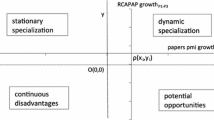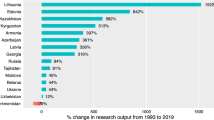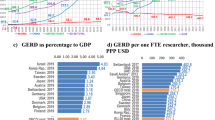Abstract
The US-EU race for world leadership in science and technology has become the favourite subject of recent studies. Studies issued by the European Commission reported the increase of the European share in the world’s scientific production and announced world leadership of the EU in scientific output at the end of the last century. In order to be able to monitor those types of global changes, the present study is based on the 15-year period 1991–2005. A set of bibliometric and technometric indicators is used to analyse activity and impact patterns in science and technology output. This set comprises publication output indicators such as (1) the share in the world total, (2) subject-based publication profiles, (3) citation-based indicators like journal-and subject-normalised mean citation rates, (4) international co-publications and their impact as well as (5) patent indicators and publication-patent citation links (both directions). The evolution of national bibliometric profiles, ‘scientific weight’ and science-technology linkage patterns are discussed as well.
The authors show, using the mirror of science and technology indicators, that the triad model does no longer hold in the 21st century. China is challenging the leading sciento-economic powers and the time is approaching when this country will represent the world’s second largest potential in science and technology. China and other emerging scientific nations like South Korea, Taiwan, Brazil and Turkey are already changing the balance of power as measured by scientific production, as they are at least in part responsible for the relative decline of the former triad.
Similar content being viewed by others
References
Braun, T., Glänzel, W. (1990), United Germany: The new scientific superpower? Scientometrics, 19(5–6): 513–521.
CHINADAILY (2006), China’s economy may have overtaken France, ChinaDaily, 14 February, 2006, Accessible via: http://www.chinadaily.com.cn/english/doc/2006-01/23/content_514710.htm.
Dosi, G., Llerena P., Sylos Labini, M. (2005), Science-Technology-Industry Links and the “European Paradox”: Some Notes on the Dynamics of Scientific and Technological Research in Europe, LEM Working Paper Series, 02/2005.
Frame, J. D. (1977), Mainstream research in Latin America and the Caribbean, Interciencia, 2: 143–148.
Glänzel, W. (2000), Science in Scandinavia: A bibliometric approach, Scientometrics, 48(2): 121–150.
Glänzel, W. (2001), National characteristics in international scientific co-authorship, Scientometrics, 51(1): 69–115.
Glänzel, W., Schubert, A. (2003), A new classification scheme of science fields and subfields designed for scientometric evaluation purposes, Scientometrics, 56(3): 357–367.
Glänzel, W., Leta, J., Thijs, B. (2006), Science in Brazil. Part 1: A macro-level comparative study, Scientometrics, 67(1): 67–85.
Hicks, D. (2005), America’s innovative edge at risk? Research-Technology Management, 48(6): 8–12.
King, D. A. (2004), The scientific impact of nations, Nature, 430(6997): 311–316.
Kostoff, R. (2004), The (scientific) wealth of nations. The Scientist, 18(18): 10–10.
Leta, J., Glänzel, W., Thijs, B. (2006), Science in Brazil. Part 2: Sectoral and institutional research profiles. Scientometrics, 67(1): 87–105.
Leydesdorff, L., Wagner, C. (2006), Is the United States losing ground in science? A global perspective on the world science system. Scientometrics, forthcoming, available at http://users.fmg.uva.nl/lleydesdorff/us_science/us_science.pdf.
Leydesdorff, L., Zhou, P. (2005), Are the contributions of China and Korea upsetting the world system of science? Scientometrics, 63(3): 617–630.
Liang, L., Havemann, F., Heinz, M., Wagner-Döbler, R. (2006), Structural similarities between science growth dynamics in China and in western countries. Scientometrics, 66(2): 311–325.
May, R. M. (1997), The scientific wealth of nations, Science, 275(5301): 793–796.
Ohmae, K. (1985), Triad Power: The Coming Shape of Global Competition. Free Press, New York, 1985.
REIST-2 (1997), European Commission, Second European Report on S&T Indicators 1997, EUR 17639, Brussels — Luxembourg.
REIST-3 (2003), European Commission, Third European Report on S&T Indicators 2003, EUR 20025, Brussels — Luxembourg.
Schlemmer, B., Glänzel, W., Radnóczi, J. (2004), A bibliometric analysis of national research profiles in the changing Europe (1983–2003). Poster presented at the 8 th International Conference on Science and Technology Indicators, held in Leiden (The Netherlands), on 23–25 September 2004.
Schubert, A., Braun, T. (1990), International collaboration in the sciences, 1981–1985. Scientometrics, 19(1–2): 3–10.
Schubert, A., Glänzel, W., Braun, T. (1983), Relative Citation Rate: A new indicator for measuring the impact of publications. In: D. Tomov, L. Dimitrova (Eds), Proceedings of the 1st National Conference with International Participation on Scientometrics and Linguistic of the Scientific Text, Varna, 80–81.
Shelton, R. D., Holdridge, G. M. (2004), The US-EU race for leadership of science and technology: Qualitative and quantitative indicators. Scientometrics, 60(3): 353–363.
Williams, F. (2006) China’s patent filings overtake Germany. Financial Times, October 16, p. 2.
WIPO (2006), WIPO Patent Report. Statistics on Worldwide Patent Activities. Edition 2006. World Intellectual Property Organization, Geneva.
Zhou, P., Leydesdorff, L. (2006), The emergence of China as a leading nation in science. Research Policy, 35(1): 83–104.
Author information
Authors and Affiliations
Corresponding author
Rights and permissions
About this article
Cite this article
Glänzel, W., Debackere, K. & Meyer, M. ‘Triad’ or ‘tetrad’? On global changes in a dynamic world. Scientometrics 74, 71–88 (2008). https://doi.org/10.1007/s11192-008-0104-5
Received:
Published:
Issue Date:
DOI: https://doi.org/10.1007/s11192-008-0104-5




